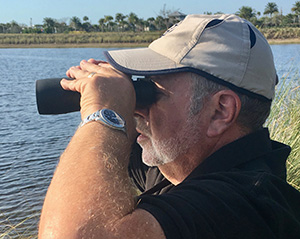Maybe I have too much time on my hands, but I recently took a birding course. Exciting, huh? The four-hour course, offered by the Rookery Bay Reserve in Naples, Florida, was terrific. I learned a lot about birds, but not in the way you might think.
Class time: Focus on tools
The first 90 minutes took place in a classroom. During the first hour, our instructor, Randy, said very little about the birds we might see. There was no slide presentation of the birds of southwest Florida. Instead, he talked about tools.
First, he demonstrated different types of binoculars—what works and what doesn’t, what to look for when buying, and how to operate them. After all, said Randy, “if you can’t see the birds, what’s the point?”
After about 30 minutes, Randy shifted to another tool, the birding field guide. These are books that provide information on birds and help you identify them. There were several field guides, and while each was designed to fit in your pocket, they were markedly different. Some were text-heavy, some had photos, while others had line drawings. A few of the guides had extensive indices and others had extensive maps. We learned how to use the guides and understood that each of them had pluses and minuses. We selected a guide to practice with that initially seemed right for us.
Only after we were comfortable with these two essential tools did Randy show us some pictures of birds. But his purpose here was also related to the tools. He highlighted different features to look for (e.g., characteristics, habits, size). He specifically told us not to be concerned with their names just yet.
So almost half the class was gone and I hadn’t identified a single bird. What was going on here? Actually, quite a lot. Whether he knew it or not, Randy was leveraging performance support within a training program. I talked about this in a prior column; Randy was putting it all into practice. Why was this so important?
First, without a fundamental understanding of the tools of birding, how could we be expected to see or identify anything later? Sure, through trial and error we might have figured it all out, if we didn’t give up out of frustration. Randy, both an SME and an outstanding instructor, recognized this.
Field work: More focus on tools

Figure 1: Your humble columnist spies a blue heron. Or is it a great egret? Time to check my field guide.
But we were not done. The rest of the course was in the field, at a bird sanctuary (Figure 1). If you were in the course and thought Randy was going to point out birds to us and tell us what they were, you would have been very disappointed.
The first thing Randy told us to do was find a bird. When we found one, he then asked us what it was. “Don’t ask me; use your field guides,” he told us. “Narrow down your possibilities by characteristics, habits, and size. What bird do you think it is?” Pure deductive teaching. We shared binoculars and field guides to find the best tools for each of us. Within a half-hour, we were identifying birds all over the place, with increasing accuracy.
Randy gave us a checklist of birds common to the area and asked us to check off as many as we could identify with reasonable certainty. He helped us, but only if we asked. By the end of the course I had identified more than a dozen.
I began to think about whether I needed an instructor at all. A little eLearning, a good set of binoculars, and a well-designed field guide might be all that’s needed. But I quickly realized Randy had another purpose, one that he was uniquely suited to provide. Throughout the four hours, in the classroom and in the field, Randy encouraged us with his love of birding and the joy of finding a new bird all by ourselves. He motivated us more than taught us, and, combined with a focus on tools and self-discovery learning, my first birding course was truly exciting. No one was more surprised about this than me.
At the end of our course, I asked Randy if he had any special training in performance support or instructional design. “Huh?” he said. I explained what I did for a living, and his response was classic. He appreciated that I noticed his technique but said that it all came from experience, peer mentoring, and common sense. He told me that he’s sat through his fair share of lectures and never-ending PowerPoint slides, and figured out quickly what not to do.
Sometimes, the right way to teach is not to teach in the traditional sense, but to provide guidance in using the right tools (performance support) and then help learners to succeed on their own. Sequence is important; get the tools right and the rest is a whole lot easier. Randy knew this. We all know this. But are we doing it?
A final note: Like this birding course, sometimes we find extraordinary “training” in the places we least expect it, like a bartending course that was a true delight. Try looking outside the (corporate) box!


